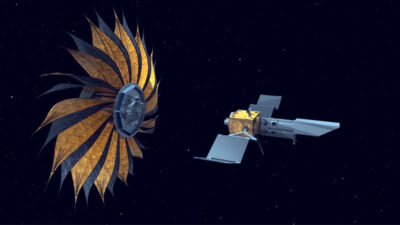Steady progress in microgravity research leveraging diverse flight platforms
By Peter B. Sunderland, Henry K. Nahra and Sunil Chintalapati|December 2021
The Microgravity and Space Processes Technical Committee encourages the advancement and public awareness of low-gravity studies in physics, materials, biological sciences and related fields.
Researchers on Earth, watching via a remote camera, for the first time observed spherical, cool diffusion flames burning gases aboard the International Space Station in June. Unlike hot flames with peak temperatures of 830-1,930 degrees Celsius (1,520-3,500 Fahrenheit), cool flames have peak temperatures of 330-730 degrees Celsius (620-1,340 Fahrenheit). The flames were observed during tests of the Cool Flames Investigation with Gases experiment. The burner was a 6 millimeter porous sphere fed by n-butane diluted with nitrogen. The ambient gas was 40% oxygen in nitrogen at 2 atmospheres. Researchers at the University of Maryland, Washington University in St. Louis, University of California San Diego and NASA’s Glenn Research Center in Ohio noticed that after the hot flames extinguished radiatively, cool flames were quickly established. The cool flames were too weak to detect except with sensitive radiometers and an intensified video camera. Measurements in these flames could help improve the internal combustion engines of the future.
The Flow Boiling and Condensation Experiment, or FBCE, flight hardware was launched to the ISS in August. Researchers from Purdue University and Glenn Research Center designed the FBCE testbed to obtain long-duration microgravity data for two-phase flow research with emphasis on the flow boiling and condensation. Any long-duration space missions would be constrained by high power and heat dissipation requirements, while maintaining low size and weight. Researchers aim to use FBCE to advance understanding of flow boiling and flow condensation prior to designing future two-phase thermal management systems with reduced size and weight.
Participants in the NASA Flight Opportunities program of the Space Technology Mission Directorate conducted some notable suborbital experiments. Among them were:
- Researchers flew the Ring Shear Drop experiment conceived by NASA’s Marshall Space Flight Center and Rensselaer Polytechnic Institute in late April and early May on a Zero-G aircraft. The parabolic flights produced data about the formation of potentially destructive amyloid fibrils, or protein clusters, like those found in the brain tissue of patients with neurodegenerative diseases including Alzheimer’s and Parkinson’s. A different version of a ring-sheared drop payload was sent to ISS in 2019 but needed hardware modifications to function properly. The parabolic flight campaign proved that the modified hardware was functioning as designed with no issues.
- A University of Florida plant experiment was flown to suborbital space in July aboard the VSS Unity spaceplane during the Unity 22 mission, Virgin Galactic’s first fully crewed flight with passengers in addition to pilots. The whole genome gene expression experiments were conducted using plants as test organisms and the Kennedy Space Center Fixation Tubes for containment. The KFTs were activated by Sirisha Bandla, vice president of government affairs and research operations at Virgin Galactic, to release a preservative that captured the plant’s biochemistry at specific points during transitions into and out of microgravity.
- The third generation of Southwest Research Institute’s tapered Liquid Acquisition Device, or LAD, flew aboard an unoccupied Blue Origin New Shepard spacecraft in August in the NS-17 mission. Long-duration space missions would require storage of large amounts of fuel at low temperatures, and a LAD would need to function properly to deliver the fuel to the rocket engine. Current LADs have straight channels and fuel moving through these channels could potentially contain vapor bubbles that could severely damage engines during ignition. The goal is to develop a tapered LAD that can eliminate bubbles via surface tension.
- In September, SpaceX’s Inspiration4, with four passengers, completed a three-day orbital spaceflight. The passengers submitted skin samples pre- and post-flight to investigate the potential effects of radiation, as the orbital altitude reached 590 kilometers, a higher radiation profile than at the space station. Other biomarkers were also measured throughout the flight to evaluate microgravity effects on human bodies.



































